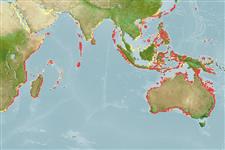| Native range | Year 2100 |

|
| Pristis zijsron AquaMaps Data sources: GBIF OBIS |
Length at first maturity
Lm ?, range 430 - ? cm
Human uses
Fisheries: commercial; gamefish: yes
Phylogenetic diversity index
(Ref. 82805)
PD50 = 0.5234 many relatives (e.g. carps) 0.5 - 2.0 few relatives (e.g. lungfishes)
Trophic Level
(Ref. 69278)
4.0 ±0.6 se; Based on size and trophs of closest relatives
Resilience
(Ref. 69278)
Low, minimum population doubling time 4.5 - 14 years (Fec assumed to be <100)